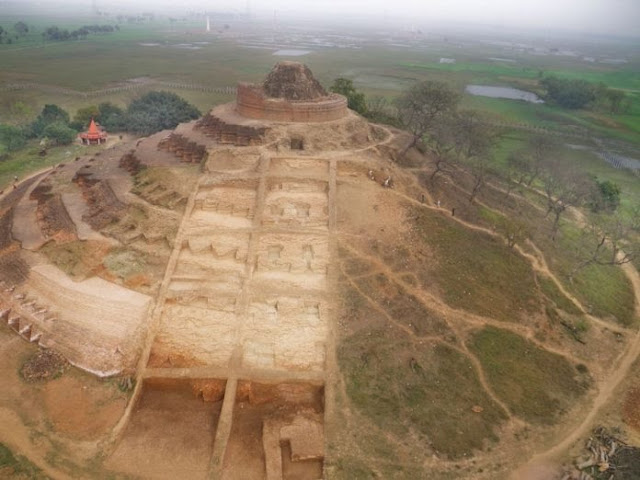Takht-i-Bahi 2025: Hidden Caves, Buried Stupa & Digital 3D Revival of a Kushan Monastery
Takht-i-Bahi 2025: Hidden Caves, Buried Stupa & Digital 3D Revival of a Kushan Monastery
(Originally published: March 2020 | Updated: October 2025 with expanded history, latest excavations, 3D scans, hidden caves, and Chinese inscriptions)
Perched on a 150-meter limestone hill in Mardan, Takht-i-Bahi (meaning "Throne of the Water Spring") is Pakistan’s finest surviving 1st-century CE Buddhist monastery. Inscribed as a UNESCO World Heritage Site in 1980, this Gandharan marvel continues to unveil secrets in 2025 — from buried stupas to digital 3D models.
This fully updated 2025 guide combines in-depth historical context, recent archaeological discoveries, secret monk caves, and modern preservation efforts.
1st Century CE: Foundation Under the Kushan Empire
Takht-i-Bahi was established during the reign of Kushan Emperor Kanishka (127–150 CE), the golden age of Mahayana Buddhism in Gandhara. The Kushans, originally from Central Asia, ruled from Purushapura (modern Peshawar) and built over 50 monasteries across the region.
The site began as a small vihara and expanded into a four-part complex:
• Stupa Court (main worship area)
• Monastic Quadrangle (50+ monk cells)
• Meditation Cells (isolated hillside rooms)
• Assembly Hall & Water Tanks (advanced hydraulic system)
2nd–4th Century CE: Peak of Gandharan Buddhist Art
Takht-i-Bahi became a center of Greco-Buddhist sculpture. Though most statues were removed, schist reliefs found here show:
• Buddha with Apollo-like wavy hair
• Hellenistic drapery on robes
• Halo and lotus pedestal — fusion of Greek, Persian, and Indian styles
Kharosthi inscriptions on stone slabs record donations by merchants, monks, and nobles — proof of a thriving economy.
With the arrival of the White Huns (Hephthalites) in the 5th century, Buddhist centers faced destruction. Takht-i-Bahi was abandoned by 650 CE but never rebuilt upon — the key reason for its preservation. Unlike Taxila, no later settlements buried the ruins.
Chinese pilgrim Xuanzang (644 CE) mentioned “ruined monasteries” near Peshawar — likely including Takht-i-Bahi.
• 1871: British officer Sir Alexander Cunningham first documented the site.
• Findings: Over 300 sculptures, votive stupas, coin hoards, and water channels
The site’s elevated position and lack of later construction made it one of the best-preserved Buddhist complexes in South Asia.
2022–2025 Excavations: New Discoveries Beneath the Ruins
The Buried “Giant” Stupa
2022 GPR survey revealed a 15-meter-wide stupa base in the northern courtyard — potentially the original main stupa.
 |
“Technology uncovers what time buried.” |
Chinese Han-Script Pottery
A 4th-century bowl fragment with Han script confirms Silk Route pilgrims stayed here.
Secret Meditation Caves: The Monk’s Hidden Retreat
Three vipassana caves on the eastern ridge:
• Soot marks from oil lamps
• Natural water drip
• Carved lotus ceiling
Only accessible with local guide Rahman Khan (Rs. 300).
Digital Preservation: Takht-i-Bahi Enters the 3D Era
Aga Khan Trust (2023–ongoing):
• LiDAR 3D scanning
• Free Sketchfab tour
Takht-i-Bahi’s Gift to Local Communities in 2025
• 50,000+ tourists (2024)• Women sell stupa replicas
• 10 homestays (Rs. 1,500/night)
Moonlit Takht-i-Bahi: Night Photography & Full Moon Permits
Night permits now available (Rs. 1,000).
• Full moon in November
• Tripod + wide lens
From Kanishka’s empire to AI-powered 3D tours, Takht-i-Bahi proves: heritage is not dead — it evolves.
Comment your travel plans — I’ll connect you with guides, homestays, and drone permits!
Note: Images from-

















Comments
Post a Comment